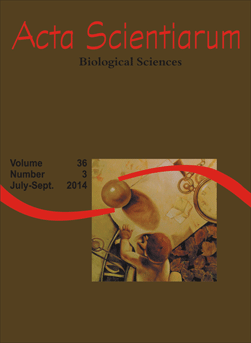<b>Haematology and melanoma crophage centers of Nile tilapia fed supplemented diet with propolis
Resumo
The objective of this study was to investigate the influence of dietary supplementation with propolis on hematology and number and area of melanomacrophage centers in spleen and kidney of tilapia. After acclimation, fish (24.7 ± 7.4 gmean weight) were distributed in 6 tanks 100 L, 6 fish per tank, in triplicate, at a temperature 24.0 ± 2.8oC, with two treatments: Fish fed 2% propolis supplemented diet and fish fed non-supplemented diet. To monitor the evolution of the effects, two samples were collected: half of the fish from each treatment were used after 15 days and the other half after 21, composing two feeding times. After each feeding time, blood, spleen and kidney were collected. After twenty one days feeding on 2% propolis supplemented diet, fish showed a lower number of total leukocytes and lymphocytes and an increase in the total erythrocytes number. Fish fed supplemented diet presented an increased number of melanomacrophage centers. We observed hemosiderin in all spleen samples. Kidney showed no significant difference on the presence of melanomacrophage centers containing hemosiderin. Despite these changes, the fish health status was not affected. The results showed that propolis supplementation in the diet ofNile tilapia may be physiologically feasible.
Downloads
DECLARAÇÃO DE ORIGINALIDADE E DIREITOS AUTORAIS
Declaro que o presente artigo é original, não tendo sido submetido à publicação em qualquer outro periódico nacional ou internacional, quer seja em parte ou em sua totalidade.
Os direitos autorais pertencem exclusivamente aos autores. Os direitos de licenciamento utilizados pelo periódico é a licença Creative Commons Attribution 4.0 (CC BY 4.0): são permitidos o compartilhamento (cópia e distribuição do material em qualqer meio ou formato) e adaptação (remix, transformação e criação de material a partir do conteúdo assim licenciado para quaisquer fins, inclusive comerciais.
Recomenda-se a leitura desse link para maiores informações sobre o tema: fornecimento de créditos e referências de forma correta, entre outros detalhes cruciais para uso adequado do material licenciado.












1.png)




3.png)













